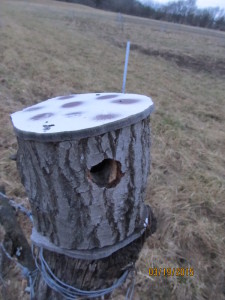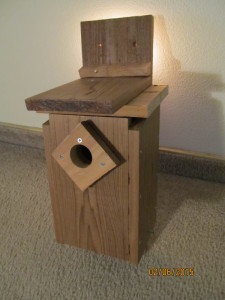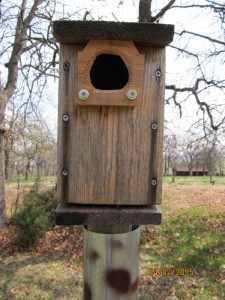Mary had a field of gold,
Anywhere Mary went, the gold was sure to glow,
And the color was so bold, that butterflies would soon follow.
Although a few trees usually die during the first two years after transplanting from pots to the field, a number of trees that were four years old died this last Winter. In most cases the graft died and the root stock sprouted new growth. But, on three Lakota trees that were planted in October, 2014, a relatively large limb that grew from near ground level on the trunk died, and the upper portion of the tree stayed alive as shown in the next two photos.
Another problem occurs when birds land at or near the top of the tree and break off the top. I do like to have birds in the orchard because they eat insects. But, when trying to train a central leader on each tree, this occurrence is frustrating.
Although it is a couple of months late, the new double jug bird feeder has finally arrived. During the cold weather I put feed out on a board for the birds to eat. They quickly discovered it and started coming by when they saw me adding more feed. The following bird feeder is designed to fit over a t-post. It is made from cedar wood and plastic one gallon jugs. After finishing it I already recognize a flaw, so, this version is numbered 0.1.
Here are some pictures of the double jug bird feeder:
Since some components of the feeder are made of food grade plastic, I wonder how long it will last out in the direct sunlight.
Whoa! What are these vermin feeding on the pecan tree leaves?
After removing hundreds of caterpillars that were feeding on the tree leaves by crushing them between my fingers, here is what little foliage remained.
The caterpillars had almost completely defoliated the tree before I noticed it. So far this is the only affected tree that I have found. And, here is a closer look at what the caterpillars leave behind after feeding.
There are lots of birds that feed on the insects in the trees and leave their poop on the leaves and protective fence that encircles each tree. Sometimes they even land on the limbs and break some off. So, why did the birds not find and feed on the hundreds of caterpillars that were on this tree?
The first buzzard of 2016 was sighted as it soared/floated around on the strong and gusty March winds on March 15. The winds were so strong that it was doing acrobatics and never even flapped its wings.
This past week I cleaned out the bluebird houses installed in previous years – six had nests from last year, one had fallen down, and the entry hole of one had been redesigned by woodpeckers making it inhospitable.
After making two more houses I put them up out in the field by attaching them to t-posts and placing a piece of metal pipe on the post between the ground and the house. The pictures below show one of them.
One of these days I hope to put up a martin house and also construct a small shed for barn swallows to build their mud nests in and poop all over any equipment stored inside it.
When I acquired the property in 2012 there were a number of decrepit bird houses spread around the property. The roofs had fallen in and they had not been occupied for a few years.
After putting up bird houses during the last three years there are now a total of eight new houses on the property that were constructed by humans. In March, 2013, I put up five houses – four that I made myself and one that a neighbour gave me. This year I made three more and put them out in the field. The diameter of the entry holes is either one and a half inches or one and an eighth inches. The larger diameter is sized for blue birds and the smaller is for chickadees and house wrens. The following four pictures illustrate the different designs used in the construction.




The smallest inside dimensions of the box shaped houses are about four inches by four inches for the floor and about six inches to the ceiling. Note the “natural log” style bird house that consists of a length of hollow tree log with a floor and roof attached to the bottom and top. Would you agree that one style resembles a chalet in the Swiss Alps?
Of the houses I built this year I added a diamond shaped block of wood over the entry hole. Hopefully, this added thickness around the entry hole will hinder the actions of self-styled carpenter birds. As you can see in the first picture below the carpenter birds (wood peckers) added their own touch to the structure of one house that was built two years ago. To make the house liveable again for blue birds I tacked on a new entry door like that shown in the second picture below. But, almost immediately the carpenter birds did their “home improvement” as shown in the third picture below.

After constructing the houses over the past few years I think two design features should be standard in new house construction. One is to have either a side door or a removable roof to facilitate cleaning. Although normally the houses are cleaned out in early March every year, if the nest gets rented out to an undesirable tenant such as a house sparrow, opening a side door or the lifting off the top permits checking who the residents are before destroying the nest. If the house can only be cleaned out by removing the floor, the whole nest falls out before you can check the nationality of the residents. A couple of the houses that I built suffer from this flaw. The other is to design the entry hole to discourage wood peckers, IE, by adding an extra layer of wood around the door.

This year I mounted the bird houses on steel posts as you can see in the above picture. It is easy to pound the posts into the ground anywhere you want and by using eight foot long posts the house will be about five feet off the ground. To discourage snakes and other critters from visiting the residents I put up a length of metal drain spout around the post to make climbing more difficult.
Oliver(holding the birdhouse in the following picture) came all the way from Germany to provide some of that well known German engineering expertise during the installation of one birdhouse.